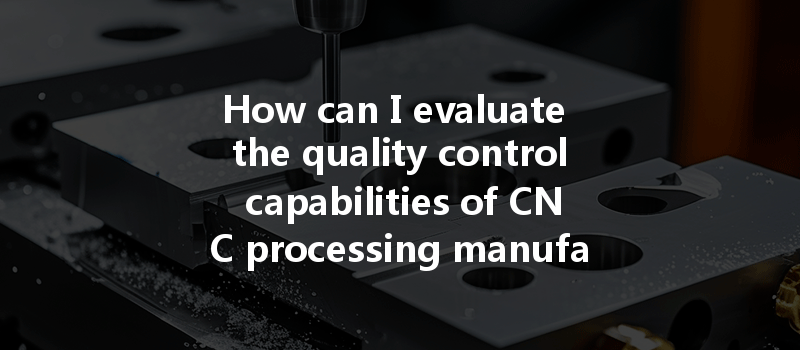Did you know that poor quality control can lead to direct costs of around 20% or more of a company’s total costs? For manufacturing, particularly in the CNC (Computer Numerical Control) processing sector, this number can rise significantly if components do not meet specified tolerances or quality standards. In today’s competitive market, the need for precision and high-quality components has never been more critical. The question then arises: How can businesses ensure they are partnering with CNC processing manufacturers that uphold stringent quality control standards?
In this comprehensive blog, we’ll explore the essential criteria for evaluating the quality control capabilities of CNC manufacturers. We will delve into various qualitative and quantitative aspects, analyze case studies, and provide actionable strategies that businesses can implement to ensure they are making informed decisions when selecting CNC processing partners. With a word count spanning 7,000 to 10,000 words, this article will serve as your definitive guide on the subject.
—
Understanding the Importance of Quality Control in CNC Processing
Quality control (QC) in CNC processing refers to the systematic processes that ensure manufactured products meet specific standards of quality. In an industry where precision is paramount, the stakes are high. Poor quality control can result not only in increased production costs but also in customer dissatisfaction and loss of market share.
The Business Impact of Quality Control Failures
Understanding these implications underscores why a comprehensive evaluation of a CNC manufacturer’s quality control capabilities is essential.
—
Key Criteria for Evaluating CNC Processing Manufacturers
One of the first indicators of a manufacturer’s commitment to quality control is their adherence to industry standards and certifications. Look for certifications such as:
Understanding the specific quality control processes a manufacturer employs is crucial. Key areas include:
The technology a manufacturer uses can significantly influence their quality control capabilities. Key technologies to consider include:
Effective quality control hinges on the ability to collect, analyze, and act on quality data. Look for:

Assess how manufacturers manage their suppliers. Effective supplier quality management can mitigate risks related to material defects and delays. Consider:
Case Studies: Real-world Examples of Quality Control in CNC Processing
Case Study 1: Aerospace Components Manufacturer
Background: An aerospace manufacturer faced increasing defect rates and customer complaints.
Solution: They implemented a robust quality management system compliant with AS9100, introduced SPC tools for in-process checks, and enhanced their training programs for quality personnel.
Result: Within six months, defects decreased by 40%, and customer satisfaction scores improved significantly.
Case Study 2: Automotive Parts Producer
Background: An automotive parts producer encountered issues with delayed deliveries and quality claims.
Solution: They adopted Lean Manufacturing principles to streamline their processes, enhanced supplier audits, and invested in advanced CMM technology for final inspections.
Result: The company improved delivery times by 30% and reduced claims by 50%, leading to significant cost savings.
Steps to Evaluate the Quality Control Capabilities of CNC Manufacturers
Step 1: Define Your Quality Requirements
Before beginning your evaluation, clearly outline your quality requirements. Determine the critical dimensions, tolerances, and finishes necessary for your products.
Step 2: Research Potential Manufacturers
Compile a list of potential CNC processing manufacturers and collect data about their certifications, quality processes, technology capabilities, and performance metrics.
Step 3: Conduct On-site Visits
If feasible, visiting the manufacturing site can provide invaluable insight. During your visit, assess the cleanliness of the facility, the organization of equipment, and the presence of quality control measures in place.
Step 4: Review Quality Documentation
Request samples of quality documentation, such as inspection reports, quality manuals, and records of internal audits. This documentation can provide insights into the robustness of their quality control systems.
Step 5: Engage in Discussions
Communication is essential. Ask detailed questions regarding their approach to quality control, how they handle defects, and how they incorporate customer feedback into their processes.
Step 6: Request References
Contact previous clients or partners to gain feedback on the manufacturer’s quality control capabilities and their overall reliability.
Evaluating the quality control capabilities of CNC processing manufacturers is not just about ensuring product quality; it’s about safeguarding your entire supply chain and reputation in the market. By systematically assessing a manufacturer’s certifications, quality processes, technological capabilities, and more, you can make informed decisions that will drive your organization’s success.
As industries continue to evolve, the importance of quality in manufacturing remains steadfast. Companies that prioritize quality control not only enhance their operational efficiency but also foster lasting relationships with clients, ultimately leading to sustainable growth.
In summary, systematic evaluation is crucial. When selecting a CNC processing partner, remember that the cost of quality goes beyond mere dollars and cents — it encompasses the trust of your customers, the integrity of your brand, and the ongoing viability of your business. By adopting the techniques outlined in this blog, you can ensure that you are partnering with manufacturers who are committed to excellence and who can seamlessly meet your quality expectations.
As you embark on your journey to find the right CNC processing supplier, keep this guide in mind. The right partner is out there, and by prioritizing quality control, you are not just investing in superior products, but also in the future success of your business.






